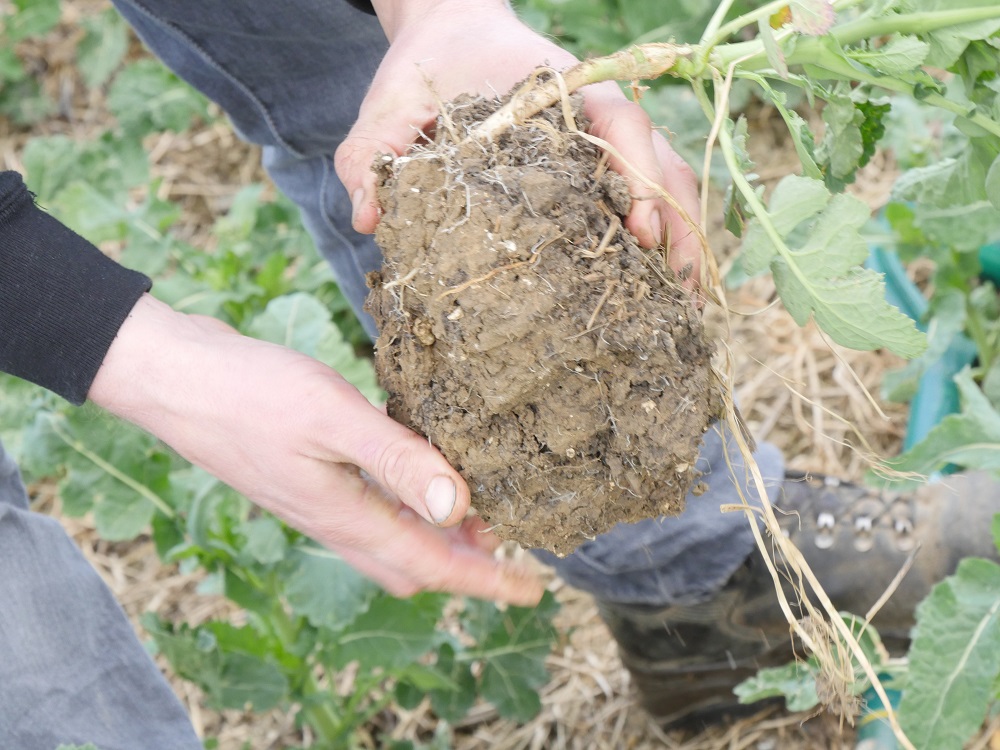- Home
- Knowledge library
- How to identify clubroot symptoms and map infested land
How to identify clubroot symptoms and map infested land
Early detection of clubroot infection is essential. As patches of poor establishment or growth can have multiple causes, it is important to investigate them and establish the cause of symptoms.
An introduction to clubroot and its management
Oilseed rape disease management guidance
What is the life cycle of the clubroot pathogen?
The pathogen that causes clubroot (Plasmodiophora brassicae) is able to survive for many years in the soil. An understanding of its life cycle will assist with disease prevention, early detection and control.
Learn about the pathogen that causes clubroot
How to identify high-risk clubroot areas
It is important to identify and map high-risk clubroot areas, via soil testing or visual inspection of plants.
Where clubroot is suspected or confirmed, establish hygiene measures around the infected area immediately and adapt rotational and agronomic plans, accordingly.
Clubroot spores persist for up to 15 years in the soil, so maps remain useful for several seasons. As patches are relatively stable within a season, targeted management of affected areas can be cost-effective.
- Record all your test results on a field map – it will help you to identify hotspots over the years and work out where to target your treatments
- Keep accurate records of any problem areas, including the scale of infection, and where you have used any varieties that are resistant to clubroot
- Conduct more frequent and detailed tests at sites that are especially susceptible to clubroot
How to test soils for clubroot
Conduct soil tests prior to planting any susceptible crop. Prioritise high-risk areas for tests, such as wet hollows, gateways/field entrances, recently flooded fields (especially those near infected fields) and where civil infrastructure projects are planned.
Tests use traditional assay techniques, such as growing susceptible bait plants in suspected infected soil, or molecular diagnostics. Molecular test results also indicate the quantity of spore DNA per gram of soil. Although suggested spore risk thresholds have been set for vegetable brassicas, no validated thresholds exist for oilseed rape.
Clubroot testing services
How to conduct visual tests for clubroot
Identification of clubroot patches in the growing crop can help guide the farm’s rotational plan.
Monitor root systems over the winter period, when fields are easier to walk and monitor. Use the field’s tramlines to establish a sampling grid. Ideally, sampling points should be no more than 50 m apart. At each sampling point, pull up and inspect ten plants.
Early symptoms
The first symptoms usually occur within six to eight weeks of planting, provided soils are moist and temperatures are greater than 15°C. Roots become swollen and distorted, and develop small, irregular, white-coloured, solid galls. These are present on taproots and/or lateral roots. As the season progresses, galls may enlarge and discolour, before starting to rot.
Later symptoms
Above-ground symptoms do not usually develop until later in the season. Typical symptoms include stunting and yellowing. Under dry conditions, plants may wilt, especially when galling is severe. Distinct patches of poor growth are often visible. Plant loss occurs in the most severely affected areas and, occasionally, the whole field may fail.
If disease levels are severe enough to cause visible above-ground symptoms, NDVI (Normalized Difference Vegetation Index) techniques can be used to help detect and map infested patches. However, such symptoms are not always present, especially in oilseed rape.
Targeted management of clubroot
Based on oilseed rape data, whole-field treatment approaches can give lower economic returns, compared with the targeted treatment of clubroot-infected patches. Mapping the distribution of clubroot across a field can aid with the development of targeted strategies. Our clubroot field-mapping case studies demonstrate the cost-effectiveness of a targeted management approach under two scenarios.

Inspection of an oilseed rape plant for clubroot symptoms
Topics:
Sectors:
Tags:

